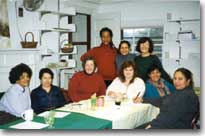This longitudinal study on Puerto Rican adolescents revealed new data that differed from previous examinations of Puerto Rican 'at risk' youth. In this study, these youths were found to be well-adjusted and close to their families, not prone (as previously assumed) to risky behavior.
This research was supported by a grant from the National Institute for Child Health and Human Development (R01-HD30592) to Sumru Erkut, Odette Alarcón, and Cynthia García Coll. Keith Crnic, Lawrence Baldwin, Nancy Genero, Norma Ware, and James Green served on our Advisory Board and provided wise counsel. We acknowledge the valuable contributions of the methodologists, Laura A. Szalacha, Lauren Goldstein, and Scott Van Manen. Linda R. Tropp, Heidie A. Vázquez García, and Ivonne Pérez served as research and field coordinators. Wanda Guzman, and Amanda Beals provided field and office support. Linda White and Tracey Thomas assisted in many aspects of the study's administration. We received assistance from Cidhinnia Campos Torres, Valentina Morales, Ingrid Gomez, Vanessa Velez, Castagna Lacet, Crystie Anderson, Susan Archambaut, Francisco Xavier Campos Torres, Marina Mesones, Megin Charner, Karima Khawja, and Alison Beals. Finally, we thank the interviewers (Jennifer Murillo, Sabrina Gonzalez, Rosa Reyes, Genoveva Algarin, and Juanita Torres Campos) and the families who made this research possible.

The Normative Study of Puerto Rican Adolescents was a prospective study of socio-emotional development in early and middle adolescence among Puerto Rican youth living in the mainland of the United States. Participants in the research were 245 Puerto Rican 13 and 14 year-olds (52% female) and their primary care givers who were interviewed once every year for three years. The research was initiated to address the lack of information on community samples of Puerto Rican adolescents. Previous research that had focused on Puerto Rican youth had often taken the "deficit" point of view and had studied samples identified through risk factors such as early pregnancy or dropout.
The sample, recruited through a mixed recruitment-referral strategy, was similar in their income and household composition to the mainland Puerto Rican population (according to 1993-94 figures, 52.1% of Puerto Rican youth younger than 18 lived in families below the poverty line, nationwide, 45% of the 13-14 year-olds in sample lived families below the poverty line; 48.4% of Puerto Rican households were headed by a single parent, 51% of the adolescents in the sample lived in single parent homes). We have confidence in the representativeness of the sample in that it included more than one-fifth of all eligible 13-14 year-olds in Boston, which was the principal sampling site from where three-fourths of the sample was drawn. Interviews were carried out by trained bilingual/bicultural interviewers in the participants' homes, conducted in the language of the participants' choice.
We have highlighted three notable methodological advances in this report, along with a documentation of the project's progress on the original aims specified in the research proposal. These methodological advances are
- The development of a new method for creating and adapting bilingual measured called the "dual-focus" approach
- Developing a psychometrically sound measure of psychological acculturation for Latinos (in English and Spanish) using the dual-focus approach
- Again, using the dual-focus approach, developing a Spanish version of Harter's Self Perception Profile which has sound psychometric properties for use in measuring self-esteem among Puerto Rican youth.
The substantive research findings were that Puerto Rican adolescents reported high levels of attachment to their parents and alliance with their ethnic heritage in early adolescence. These patterns strengthened rather than diminished across the three waves of data collection into middle adolescence. We have interpreted the high levels of ethnic pride and increase in Puerto Rican cultural orientation as an "ethnic identity intensification" during early and middle adolescence. Additionally, Puerto Rican youth reported high self-esteem and lower levels of risk taking behaviors compared with their peers from other racial/ethnic backgrounds. These results did not vary by adolescent gender or by family socio-economic status. The major gender difference of note is the greater intensification in Puerto Rican acculturation between early and middle adolescence for girls who had been born in Puerto Rico in contrast to the other participants.
The major implication of these findings is that research on community-based samples can reveal different portraits of minority youth development than studies that examine youth having been identified as being "at risk" or in need of services. The picture of Puerto Rican youth which emerged from this longitudinal study of a community-based sample during early and middle adolescence presents these youth as well adjusted, attached to their family, peers and ethnic community, proud to be of Puerto Rican heritage, and not prone to engaging in risky behaviors. This picture contradicts the view that equates being a minority adolescent with poor developmental outcomes. Moreover, our research on Puerto Rican youth documents the role of culture in providing alternative developmental pathways of socio-emotional development during early and middle adolescence, which has been lacking in the literature.


